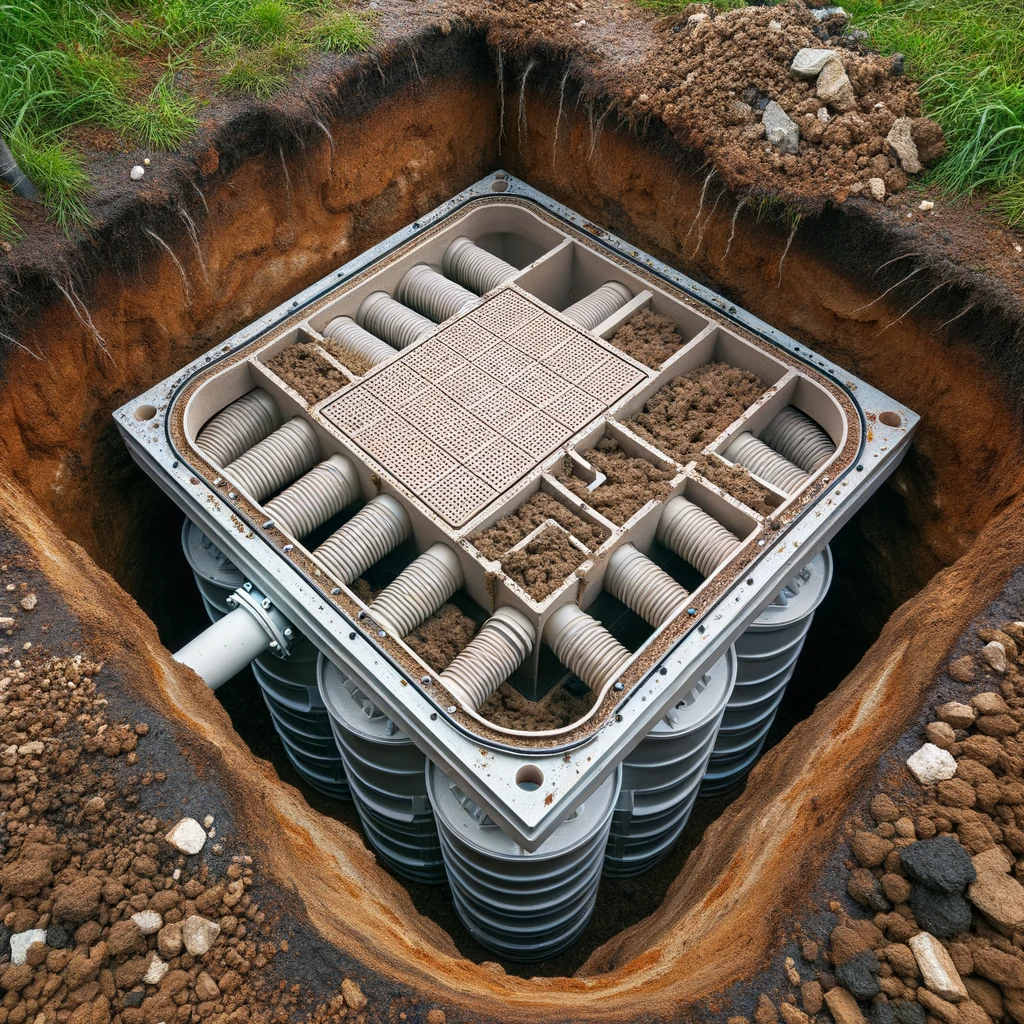How To Replace A Septic Tank Lid- Guide
In this article, we will teach you all about your septic tank lid, how to find it, what it does, and how to replace it.
A septic tank lid is the top-most portion of a sewage tank. This is your primary access into the septic tank. As a crucial maintenance procedure, this lid needs to be removed every few years in order to empty out the septic tank. Several septic tank installations have special risers that position the tank lid at ground level. If yours is not fitted with a riser, you’ll need to dig for the lid of your septic tank. Typically, all components of the septic tank, including the lid, are buried between 4 inches and 4 feet underground.
Why is it important to know the location of your septic tank lid? To most, the lid to a septic tank might seem insignificant, but the truth is it is actually one of the most essential parts of a septic system. Eventually, your septic tank will fill with solids and will need regular pumping out to preserve healthy working conditions. Depending on the size of a septic tank, a good rule of thumb is to have it pumped out every three to five years. It is essential not to let your septic tank get too full as sewage may start to back up into your house or facility, or may overflow out of the lid. This causes potentially severe (and expensive) damage to the tank.

Removing the septic tank lid is relatively easy and is typically done for pumping and/or inspection. Also, over time, septic tank lids may suffer damages, requiring a replacement. A weak seal around the lid may allow septic odors to escape and, worse, allow foreign objects into the tank. This may cause clogs or flooding within. This is why it is also imperative to inspect and replace this lid regularly.
Let us take a look at a basic step-by-step guide on how to remove and replace a septic tank lid.
Step 1 – Locate the Septic Tank Lid
The first step to removing or replacing a septic tank lid is, of course, to locate the septic tank. This may actually be more difficult than it sounds, especially if you are not the first owner or have a larger property.
Try the quick and easy way first: either contact your local septic pumpers, past property owners, or the health department in your area. They may be able to help you locate the position of your septic tank and save you a lot of time and effort looking for it. Most jurisdictions keep records of building permits, including the installation of septic systems on a particular property. Typically, these documents include a diagram with dimensions of the septic tank (if it exists) within any given property. Also, a diagram of your septic system may be included as part of the property inspection during the purchase process.
There are two other ways to locate your septic tank, but these require a little more time.
A second way to possibly locate a buried septic tank is to use a metal detector. While it’s true that most tanks today are made out of concrete, septic tanks commonly have metal rebar in them. With the use of a metal detector, you can be led to the approximate location and start a more thorough search. When you reach the general area by way of the metal detector, you can use a metal pole to poke into the earth and locate the tank more precisely. Simply poke the metal pole into the earth about 12 to 14 inches. Once you strike something solid, continue in the area to determine that it is the tank. This can be time-consuming if the deed to your property was not written accurately.
A third option is to follow the drain pipe that comes from your home or building. Your septic tank and drain field would typically be installed parallel to the sewer line that runs from your facility and into the yard. In the basement or crawl space (if you have this), you may be able to locate a 4-inch sewer pipe where it leaves the facility and leads to the tank. “Follow” this pipe across your yard by probing every two feet or so. In general, septic tanks are required to be at least 5 feet away from the house or building, although anywhere between 10 and 25 feet away are more common.
Note that in an unfinished basement, finding the sewer pipe may be easy as you can see where all the sewer pipes come together and leave through one of the walls. If you have a finished basement, you might need to go up on the roof and find the vent through where sewer gases escape. The sewer pipe exit will usually exit the basement wall just below this vent. Observe within 10 to 25 feet from the location of the pipe exit for a patch of grass or vegetation that looks greener and healthier than the rest. You may then use a metal detector to confirm the exact position of the tank before you begin digging.
Step 2 – Dig Up the Septic Tank Lid
After you have located your septic tank, you can begin digging up the lid, as necessary. Simply use a shovel to excavate the ground around the tank until you locate the lid. It should be flat against the tank with a small seam around it. Dig up the ground to create at least 16 inches of clearance on all sides around the lid.
It will help if you can secure an As-Built record of your property’s septic system as this will indicate how many lids there are for your particular type of tank. Depending on the septic tank set up on your property, your tank could have two or three lids. Typically, septic tanks are rectangular with approximate dimensions of 5 x 8 feet. In most cases, septic tank components (including the lid) are buried anywhere between 4 inches and 4 feet underground. You may use a metal probe to locate your tank’s edges and mark the perimeter. If you cannot find the lid by probing, use a shovel to make a shallow excavation along the tank’s perimeter. Doing so should reveal the lid.
Often, the septic tank lid is above ground and digging will not be necessary. In this case, you will simply need to identify the patch of lush vegetation and cut back longer grass or clear the area of debris in order to access the lid.
Step 3 – Determine the Type of Replacement Lid that You Need
Most septic tank lids are either 21 inches or 24 inches wide. It is important to accurately measure the width of the lid that you have. Next, find out what type of material the current lid is made out of. It could either be PVC, a high-density polyethylene, or concrete. If the lid to your septic tank is concrete, you may want to consider replacing it with a PVC or polyethylene version as the latter are more waterproof and lightweight.
Septic tank replacement lids may be purchased from larger hardware stores or a septic tank supplies distributor. Expect to pay around $100 for a concrete lid, $200 for polyethylene, and upwards of $200 for PVC.
If your septic tank is buried underneath an area where vehicles or heavy machinery may drive or operate over it, special heavy-duty septic tank lids are recommended. Discuss this option with your trusted septic tank contractor.
Step 4 – Remove the Septic Tank Lid
Depending on the size of the septic tank, the lid can be quite heavy. It may have a handle to pull on, but septic tank lids will mostly require a pry bar to lift them out of their seating. Set the pry bar in the seam and press down. As the lid lifts out of its hole, move it to the side (with someone’s help) and out of the way.
If your current septic tank lid is made of concrete, you will require a backhoe to lift and remove the lid and risers since it’ll be too heavy to do so yourself. In this case, hiring a contractor may be more ideal as they will have the equipment and the expertise to install the new lid if you prefer to stay with a concrete lid.
If what you have is made with PVC or polyethylene, you should be able to remove the septic tank lid independently — or with some assistance (as recommended by manufacture’s instructions). PVC lids are easier to install yourself because bonds adhere easily to the lid, making it simpler to fasten it to a tank. Fiber plastic materials are likewise sturdy and won’t need treatment to make it last. A polyethylene septic tank lid needs to be domed to reinforce it. Make sure to follow the manufacturer’s instructions included with your chosen product.
At this point in the process, you will need to exercise extreme caution. If the septic tank lid or access opening has indications of even a partial cave-in (sunken), treat the situation as highly hazardous. An unsafe septic tank cover poses a danger of collapsing and/or someone falling into the tank – which is potentially fatal. Keep people and pets away from the septic tank area until you’ve had the tank inspected and opened for further inspection by a professional service provider.
At all times, be absolutely certain that your septic tank lid and clean-out access covers are secure and durable so that it will be impossible for anyone to fall into the tank and that a child could not remove the cover.
After you’re done removing and replacing the lid to your septic tank, use a shovel to bury the lid again (if necessary). And when you’ve completed the whole process of locating, unearthing, removing and replacing your septic tank lid and cleanout port, make a diagram indicating the location of your septic tank for future reference. That is, if you do not have this already.
We cannot reiterate enough the importance of monitoring and maintaining the quality of one’s septic tank lid. When a septic tank is full, water will easily leak in through any opening, such as the manhole cover, the inlet/outlet pipes, or the septic tank lid itself, resulting to further flooding with groundwater that may carry soil and silt. Floating scum will then rise and possibly plug both the inlet and outlet pipes. Also, water from the flooded drainfield may flow into the septic tank.
What typically causes damage to a septic tank lid? Though it is possible to install septic tank covers that have been rated as able to withstand heavy loads such as motor vehicles, generic “as-installed” residential septic tank covers are typically not built for withstanding such weight, not to mention constant traffic over it. Subjecting your underground septic tank to considerable weight from cars, trucks, tractors, and the like, especially over a long period of time, risks damaging the tank. Driving, parking, or building infrastructure over septic tanks may compromise your septic tank lid, possibly leading to a cave-in and a whole host of costly problems.
Is it Possible to Repair a Septic Tank Lid?
Functionally, septic tanks are similar though they may vary in fabrication, shape, or configuration. Older septic tanks are commonly metal and require periodic replacement once rust corrosion sets in. Newer tanks are made of concrete or fiberglass and are installed with access covers or risers with lids for easy access especially for inspection or pump-outs. Regardless of the tank’s configuration or material, repairing a septic tank lid will be more cost-effective than replacing it with a newly-purchased unit.
Most common damage to septic tank lids would be cracks that could develop over time and with external pressure. Septic tank lids are prone to cracks from weight pressure (since they are typically buried) due to the driving of vehicles or operation of heavy machinery over the spot.
If what you have is a concrete septic tank lid that needs repairs, here’s how to do it. First, clean loose debris from around the damaged area of the lid. With a wire brush, rough up the area to improve the surface for better adhesion to new concrete that will be applied. Mix enough concrete by gradually adding water with a pitcher or bucket instead of a water hose. You are after a “muddy” consistency as a “soupy” concrete mix is ultimately weak and will be prone to future damage quicker than is normal. Apply this concrete mix to the damaged area of the tank lid using a wide trowel. Fill the area until level full and shape the concrete with the trowel. Allow about 24 hours for the concrete to cure before moving the tank lid.
Fiberglass septic tank lids are a tad more complex to repair. You need to remove the fiberglass lid from the tank and cover the hole with a large sheet of plywood. Clean the fiberglass lid with paint thinner or mineral spirits in order to remove all dirt, grease, and other build-ups, then dry thoroughly. Cut a fiberglass cloth with a pair of household scissors. Overlap the cloth at least two inches beyond the damaged area. Screw on a piece of plumber’s strap across any split areas on the tank lid. Self-tapping screws driven with an electric drill will work fine, as well. With an old paintbrush, paint liquid resin onto the damaged area. Leave room for the fiberglass cloth you’ve cut out by spreading the resin a couple of inches beyond the damage. Lay the fiberglass cloth onto the tank lid, maneuvering it into place until it completely covers the damage. Make sure there are no air bubbles or wrinkles from the fiberglass cloth before applying a heavy topcoat of resin with the paintbrush. Brush on a heavy top-coat of resin and allow 24 hours to cure. Once the curing period is complete, remove the temporary plywood cover of the septic tank and install the repaired fiberglass lid.
How Deep Should a Septic Tank Lid Be?
Septic tanks can be buried virtually at any depth underneath the ground. Though in most cases, all components of the septic tank including its lid are buried between 4 inches and 4 feet underground. The primary factors that will determine the actual depth at which your septic tank needs to be buried include:
Sewer line depth. This is the depth at which the lowest sewer line leaves your home or building. The tank should be lower than this exiting sewer line from the building it serves. This is because we usually rely on gravity to move sewage from the site and into the septic tank,
Site conditions. The presence of rocks, obstructions, and the shape of the property are factors in determining the location where the septic tank is suitably buried. If a site has a bedrock or large boulders close to the surface, the tank needs to be located elsewhere. The further the tank is buried from a facility, the deeper the tank should be, especially if the system uses gravity to move sewage.
Availability of Sewage Ejector Pump. If you have a sewage ejector pump or grinder pump system that moves sewage from your home or building to the septic tank, then your septic tank can be placed virtually anywhere in the property, including an uphill area. The same goes if there is a sewage effluent pump that moves effluent from the septic tank to the drainfield. A septic tank may be located downhill relative to the drainfield.
Manufacturer’s recommendations. There are some advanced septic treatment designs that require very particular inspection and/or maintenance guidelines performed by trained system operators.
How deep a septic tank needs to come with two additional recommendations. One is septic tanks buried deep requires a riser to be installed. Septic risers are wide-diameter “wells” installed over a septic tank’s inlet baffle access port (and possibly outlet) to allow easy access for septic tank pumping, inspection, and repair of baffles. If the septic tank is buried more than just a few inches below ground surface, installing a septic riser is still a good practice as this permits better access to the septic tank, likewise for inspection and cleaning.
Another thing to remember is you shouldn’t put a septic tank any deeper than is necessary, especially if your system relies on gravity to move effluent from tank to the drain field – which is commonly the case. Plumbing providers usually install sewer lines to slope down from inlet to outlet, at 1/8″ to 1/4″ per foot of waste pipe. Also, you don’t want the septic drain field to be buried at an unnecessary depth since the absence of oxygen deep in the soil prevents the thriving of aerobic bacteria that are needed to digest and process septic effluent.
The Cost of Replacing a Septic Tank Lid
The septic tank lid covers and provides access to the septic tank. Metal septic tanks would typically have metal lids that will be prone to rust corrosion over time and will need to be replaced. On the other hand, concrete septic tank lids may also develop cracks. Minor cracks can be repaired, but severe damage will entail a lid replacement.
The repair or replacement of septic tank lids must be handled immediately in order to avoid accidents, as a rusted or cracked septic tank lid can be a danger for anyone who may wander above it. Standard steel septic tank replacement lids can range in cost from $30 to $70. Installation charges will, of course, apply if you hire a contractor to accomplish the replacement. Meanwhile, if the septic tank lid is made from concrete, expect the cost of replacement to be a little higher as special equipment will be required to remove the old lid and install the new one.
Are Septic Tank Risers Important?
As earlier described, a septic tank riser is a dense plastic installation that runs vertically up from the top opening of the septic tank which will provide septic technicians easy access when inspecting and pumping out the contents of the septic tank. While the riser may appear to be a very simple component, it is often missing from standard septic tanks, especially those of particularly dated designs. The septic tank riser brings the tank’s access lid to the surface. Septic tank risers eliminate the need for digging up the yard in order to access your septic tank lid for repairs, pump-outs, or inspections. Typically, the septic tank riser and cover measure about 12 to 24 inches in diameter. The height of the riser will depend on how far into the ground the septic tank has been positioned. A septic tank lid will cover the opening of that septic riser and typically extends through the surface of your lawn or ground surface. So the quick answer is, yes — septic tank risers and covers make accessing your tank easier for you, the septic inspectors, and the septic pumpers.
The Dangers of Replacing Septic Tank Covers
A poorly maintained septic tank system may have become vulnerable to collapse or cave-in over time, posing physical hazards to people and pets even with the slightest external force or pressure. Merely stepping on a cracked or compromised septic tank lid can be very dangerous.
Septic tanks are potentially dangerous as they contain various toxic sewer gases which pose health risks when inhaled. Sewage gases are composed mainly of methane which can be extremely toxic, especially in high concentrations. Aside from possible methane gas explosion and asphyxiation hazards, septic tanks could be susceptible to collapse or cave-in if left un-monitored and un-maintained. Poorly maintained septic tank systems can also present health risks caused by unsanitary conditions such as bacterial or viral infections.
It is never wise to enter a tank to work on it, even to retrieve another person who may have found his way inside it, unless you are specifically trained for such a task and are wearing special clothing and equipment, including a self-contained breathing apparatus. Instead, it is always more advisable to call on emergency services and septic system professionals.
It is imperative to always observe safety measures in and around your septic system, especially by the septic tank opening. Educate every occupant on all safety precautions to be observed when they are within the vicinity of your septic system, especially when working on or near the septic components. For instance, as much as possible, no one should ever lean over the opening of a septic tank. The gases that emanate from the tank could be noxious enough to make anyone pass out and fall into it, which could be highly fatal. Also, if one is to work in or around a septic system, it is important to cover whatever open cuts on the skin that may be present and then properly wash up and disinfect afterwards. Septic systems are potential sources of serious bacterial and viral infections.
If there is even the slightest doubt about the condition of the septic tank cover, you should cordon off the area and prevent anyone from walking over it. When replacing the septic tank lid, carefully take note of whatever damaged spots there may be. At this point, if you do detect damage areas, you should start thinking about whether you can repair or will need to replace the septic tank lid. When inspecting your septic tank lid, ensure that the septic tank lid is effectively sealed against any significant surface or groundwater that could seep into the tank. Most of all, it is crucial to make sure that the septic tank lid is securely set in place so that it cannot be moved, tipped, or opened by a child. Always regard loose septic tank lids as a risk for fatal septic tank fall-in.
Once you notice a crack on your tank’s lid, it is recommended that you immediately hire a contractor to inspect the rest of the tank for further damage in the structure. Take note, though, that while it may seem simple to repair a cracked septic tank lid, it is still best to let professionals handle the job.
Now that you have gone through the entire process of locating your tank and possibly digging up the lids (and hopefully adding risers), you should keep that area marked and visible. This makes future routine inspection and maintenance efforts easier as you do not need to undergo the tedious search again. And though septic tank lids can be a somewhat of an eyesore, there are several ways that you can “hide” your lids in plain sight. You may cover them with lightweight objects like a plastic rock, a birdbath or a planter box. The good news is you can get creative in disguising your septic tank lid. The only thing to remember is that the lid to your septic tank needs to remain easily accessible for what is hopefully periodic and regular maintenance practices. Always maintain convenient access to the septic tank as this is necessary, not only for routine inspection and maintenance but for emergency repairs that you might need down the road. It is critical to use only high-grade septic tank lids that can withstand severe environmental conditions and will not be easily removed. This ensures the safety of children, pets, and other unwitting adult occupants of the property. It is likewise good sense to keep “as-built” records and diagrams of your septic tank system for everyone’s future reference.
Visit our State Directory For Local Septic Pumping, Repair, & Installation Service Providers
https://www.doityourself.com/stry/how-to-replace-a-septic-tank-lid
https://www.ag.ndsu.edu/flood/home/what-to-do-with-flooded-septic-systems-1
https://www.doityourself.com/stry/how-to-remove-a-septic-tank-lid
https://inspectapedia.com/septic/Septic-Tank-Cover-FAQs.php
https://inspectapedia.com/septic/Septic_Tank_Covers.php
https://inspectapedia.com/septic/Septic_Tank_Opening_Procedure.php
https://inspectapedia.com/septic/Septic_Tank_Close_Procedure.php
https://www.ehow.com/how_6619969_repair-septic-tank-lid.html
https://www.flohawks.com/blog/4-easy-ways-to-find-your-septic-tank/
https://inspectapedia.com/septic/Septic_Tank_Depth.php
https://homeguides.sfgate.com/lid-septic-system-50445.html











